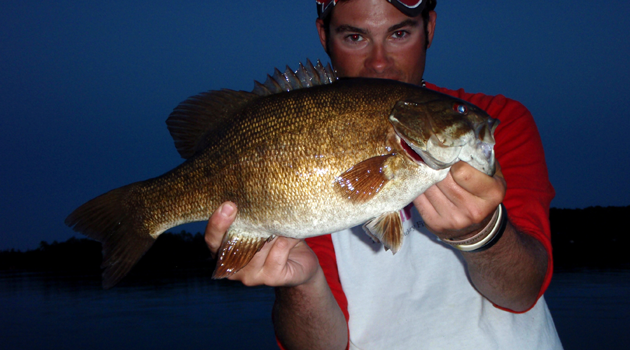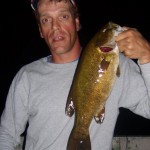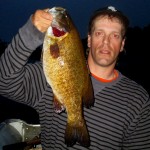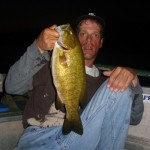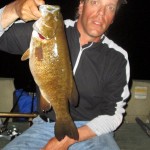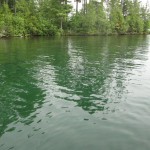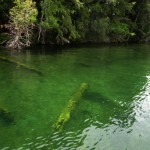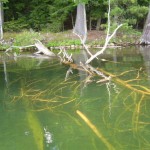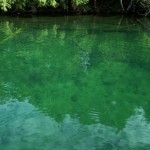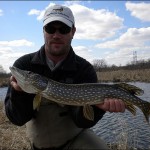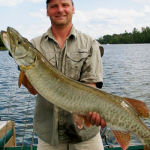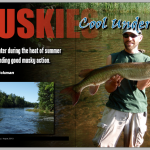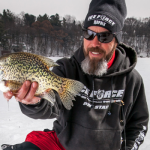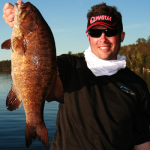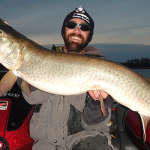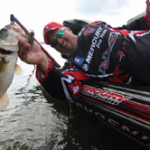By Andrew Ragas
During the dog days of summer on many north country lakes, big smallmouth bass become creatures of the night. When nighttime calls, and most anglers are asleep, the fish go nocturnal and feed.
It’s the middle of summer. The daytime surface temperatures on my favorite natural lakes and flowages is hot. Water temperature is at its seasonal peak, sometimes warmer than bath water. Due to these conditions, daytime angling for the coolwater smallmouth bass is a struggle and often a kick in the butt. When dealt with the adversity of the dog days of summer, the best strategy I’ve learned is to sleep or work all day if needed, then launch the boat late and fish later.
The dog days of summer triggers a late night feeding binge. Deep dwelling gamefish species retreat from their mid-lake open water locations and cool water sanctuaries, encroaching shoreline areas and littoral zones in search for prey. On the many natural lakes and flowages I fish, smallmouth bass undertake this short-distance movement to feast on the abundance of rusty crayfish and unsuspecting preyfish and insect hatches. During a nocturnal period when most anglers think smallmouth bass go dormant, loud surface topwaters and vibration-emitting hardbaits score gargantuan fish that are feeding heavily to retain their weights. The late night show begins.
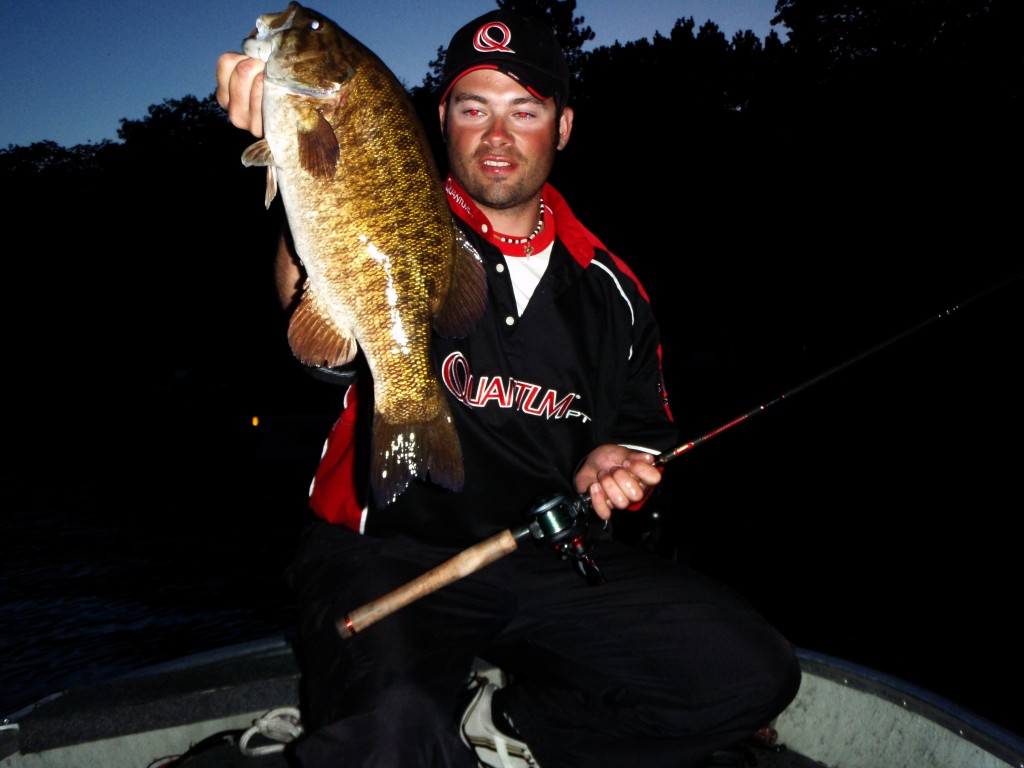
The Late Night Show
Beginning in mid July and lasting throughout August, a unique feeding window emerges on some of my favorite northern lakes. Lasting anywhere from four to six weeks, depending upon region and climates, I’ve observed more big bass feeding at night rather than daytime. Triggering this feed are consecutive warm, humid, windless nights with air temperatures warmer than 60 degrees. Moon phase and light levels can play a role also, though it’s a minor factor. During these prime conditions, the late night show fishes best on lakes with rusty crayfish infestations as it’s an easy food source and crayfish themselves are most active at night.
On the clear and dark water lakes of northern Wisconsin, trophy hunters are beginning to take notice of this nighttime feed. Like me, fellow smallmouth aficionado, Johnny Amato, theorizes that successful smallmouth angling at night greatly correlates with crayfish locations and their activity levels. Knowing that crayfish are actively feeding at night makes sense that smallmouth would, in turn, be feeding on them.
Amato, 40, a guitarist and music teacher who predominantly trophy hunts the clear waters of Forest County, Wisconsin, has caught smallmouths at night up to 21 inches.
“The night bite seems to begin slowly sometime during post-spawn, and greatly picks up as the summer progresses. Late July into August is the peak season, and it’s usually effective until mid to late fall when water temperatures take their first plunge,” says Amato.
The dog days are difficult for obvious reasons, and that’s often due to hot temperatures and lethargy. On the hot sunny days, if you are hot, the fish likely are too. “I’ve experienced many slow summer days where the fish turned on and fed ferociously as soon as the sun went down. Big, inactive smallmouth that are sitting on their deep rocks all day have to feed eventually, and during the nighttime hours they can be on the prowl much more comfortably without the sun beating down on them. They can also use stealth to sneak up on unsuspecting crayfish in the dark,” Amato explains.
Late Night Locations
Nighttime feeding locations will vary according to the prey species populating the lake. “It’s not so much as what smallmouths favor, but it’s more what the forage favors. They are going to go where the food is,” Amato affirms. “For instance, if all the crayfish in a lake were populated on one single sandy flat, smallmouth would follow them there. If it was a weedy mud flat, they would follow them there too. At night they are ultimately going to go where the food is.”
On our northwoods lakes that are populated by them, rusty crayfish make up 60% to 80% of the smallmouth’s diet. There are so many present that fish can eat whenever they want.
Because this after dark summer pattern is influenced by crayfish movements and location, shallow water environments in depths between 5 to 10 feet are the most ideal starting points. Usually, these shallow depths encompass luxurious crayfish cover such as laydowns and downed wood, fish cribs, gravel, and rocky shoals. “It’s these shoreline flats with habitat that are the best night spots,” says Amato. He also adds, “A few of these flats extend out, quite far, into the main lake. Fish will roam the entire expanse of the flat at night, not just the shorelines.”
Besides shorelines and their extensions, the pattern may work on shallow rock and boulder filled mid lake structures. On my lakes, however, they are usually a hit or miss. Amato, however, has enjoyed success on them. These mid lake structures have been so hot at night for him that by the time he concludes his outings he often fails getting over to his shoreline spots.
“Whether fishing shoreline flats or mid-lake structures, you can be getting no bites at all, thinking fish aren’t present. Then all of a sudden a monster strikes. You might make that same cast 20 times and finally catch it on the 21st cast. That’s just how smallmouth can be. They tend to move around a little more at night. Coverage of feeding areas and some persistence pays off,” Amato reveals.
Late Night Techniques
At a nocturnal period when most anglers think smallmouths go dormant, loud surface topwaters and vibration-emitting hardbaits score gargantuan bass that are feeding heavily.
Although 50 miles of lakes and highways separate mine and Amato’s home lakes, we have independently settled on similar presentations to catch smallmouth. We both agree that vibration-rich crankbaits, noisy topwaters, and crayfish imitations receive the most cracks at fish.
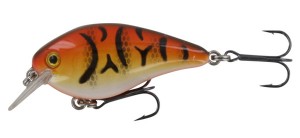
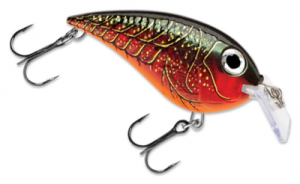
Strike King KVD Squarebill and Rapala Crankin Rap 05
I start each night on habitat-rich shorelines and main lake flats that are known crayfish and smallmouth feeding grounds. I meticulously cover these areas by power cranking, fan-casting with loud rattling crankbaits such as the Rapala Crankin Rap 05 and KVD Square Bill. As my most successful nighttime smallmouth lures to date, I have found these crankbaits to possess the loudest rattles and widest, most compact vibration. Both properties are critical to triggering strikes at night. For my power cranking approach, I put the traditional flexy crankbait rod and low gear ratio reel aside and fish with 7 ft medium to medium-heavy Quantum Tour Edition casting rods paired with Quantum Catalyst and Tour Edition PT reels with 6.3:1 and 7.3:1 gear ratios. This power gear is spooled with 10 to 14 lb Cortland Endurance monofilament and Camouflage copolymer lines.
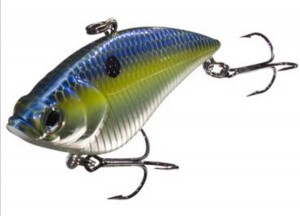
Amato also does a lot of power cranking at dark, but often with lipless crankbaits such as the Bass Pro Shops XPS brand. “I simply fan-cast a shoreline area, from left to right, or vice versa. Keeping mental note of where any big logs or boulders might be during daytime, I’ll usually be casting within 25 yards from the shoreline, parallel to it.” With the lipless crank, Amato employs a slower retrieve with occasional twitches, keeping the bait within an inch off the bottom. His biggest bites of the night often come after a twitch.
Because lakes fish differently and conditions don’t often repeat themselves on a nightly basis, it’s important to have a variety of baits ready.
“Besides the lipless crankbait, I will often switch back and forth between a tube jig, topwater, and shallow diving minnowbait. I usually have all four rigged and ready on my rods,” says Amato. “If one bait is getting most of the strikes, I will continue using it.”
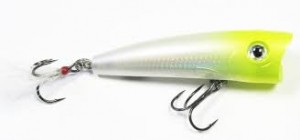
Rapala X-Rap Walk
Topwaters and surface baits, longtime bass fishing staples at night, are popular for smallmouths. They are hard to beat when surface activity is prevalent, and insect hatches take place. When the hatch is on, insects land on the surface and get stuck, often getting eaten quickly. Some favorite walk-the-dog baits I’ve enjoyed fishing with are the Rapala Skitter Walk and Zara Spook. Additionally, prop baits such as the Rapala Skitter Prop and Heddon Torpedo are great options. Lastly, poppers such as the Storm Chug Bug and the new Rapala X-Rap Pop are very effective also. For topwaters I use the same rods and reels as I do with my power cranking approach.
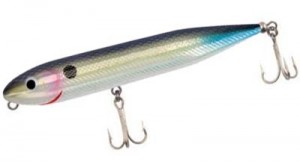
Heddon Zara Spook
For topwaters, Amato likes the Zara Spook or a floating Rapala and Rebel Minnow. With the Spook, Amato uses a 6 foot medium heavy spinning rod because “It’s easier for me to walk-the-dog while keeping the rod tip pointed downward.” Meanwhile with a floating minnowbait, he uses a 7ft medium fast action jigging rod. “With the rod tip pointing upward, I lightly shake the bait so it vibrates below the surface, and then pause it.” In the water, this resembles a dying dragonfly or minnow that can’t swim anymore. “It’s a very deadly technique,” he confesses.
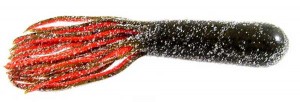
Chompers Ultra Pro Tube
Besides fishing with noise and vibration, a jig bite can continue after dusk. When this develops, “Just keep throwing it,” Amato insists. Snags are an inconvenience after dark, but if he’s still getting consistent pick-ups with the Chompers Tube and Twintail, and Yum Craw Tube, Amato keeps jigging into the night.
“Smallmouth have very good eyesight and they can see and sense the jig on the bottom well into the night,” says Amato. “I will usually switch off, making a few casts with each to see which gets hit first. The first strike often dictates what I will use for the remainder of the night. However, If I’m seeing a lot of fish feeding on the surface, I will throw the Zara Spook more.”
Be The Night Owl
When night fishing, we usually can’t see our surroundings and don’t have any visual targets other than what memory tells us and our fish locators and chart plotters display. Unless the fish are jumping nearby and ripples are seen under the moon lit sky, we are ultimately relegated to blindly casting to our suspected targets. Daytime scouting of your nighttime spots, whether it be through mental memorization or simple lake mapping, are at the forefronts to nighttime angling success.
What’s nice about mine and Amato’s northwoods lakes is our night spots usually aren’t too far away from the dock. “Often times, on most lakes, there are plenty of great spots within a football field or two away from the launch. If something goes wrong, you don’t want to be miles away,” says Amato.
Scouting and special planning is important if you want to be as nocturnal as the hungry smallmouth bass are, says Amato. “Often when I’m moving from one spot to another, I’ll move close to shore to memorize its structure, which is the key for night fishing. I’ve been doing this for such a long time now that I feel I know my home lake and most of its shorelines very well.”
Safety at night is also important. If it’s windy, Amato and I won’t bother to fish at night. Wind makes it more difficult to fish topwaters, and it impedes ideal boat control. “It’s harder to see, and harder to keep your line running in tune with your baits,” says Amato. The key to successful night fishing, answers Amato, “Is to make shorter casts. No need to bomb casts at night, that’s just asking for trouble and possibly a shoreline accident with either you or the boat.”
As a night owl requirement, we recommend taking all safety precautions before launching the boat at dusk. Always wear your life jacket or PFD, keep navigational lights running at all times, and only bring the necessary gear needed so that hook accidents don’t happen and excess gear doesn’t get damaged from boat clutter.
During the dog days, you can wake up at dawn like everyone else and be off the lake by late morning. Or you can be the night owl who fishes late and stays later when the biggest fish in the lake are feeding on easy prey. The decision by now is an easy one. Be the hunter at night and catch (and release) that mid-summer trophy.
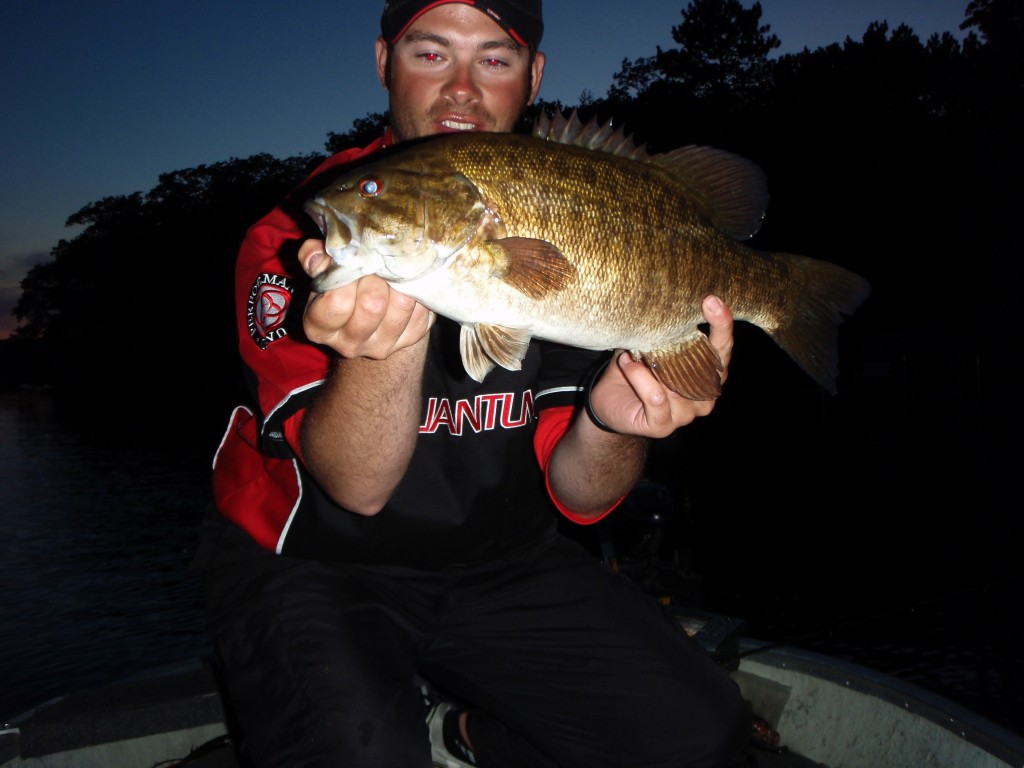
Article by Andrew Ragas, published in Fishing-Headquarters Online Magazine, issue 19, July & August, 2014.


